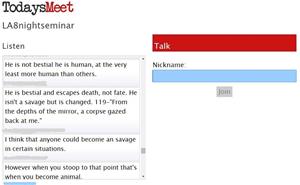 Most seasoned teachers can point to a few instructional methods that have been “game changers” in transforming their practice. Some of the most compelling moments of my career have emerged within the context of a face-to-face discussion method, the Socratic seminar. As a technology integrationist, however, I also love the possibilities afforded by digital discussion forums: increased engagement, time for articulating one’s thoughts, a written record of contributions, among others.
Most seasoned teachers can point to a few instructional methods that have been “game changers” in transforming their practice. Some of the most compelling moments of my career have emerged within the context of a face-to-face discussion method, the Socratic seminar. As a technology integrationist, however, I also love the possibilities afforded by digital discussion forums: increased engagement, time for articulating one’s thoughts, a written record of contributions, among others.
If you aren’t familiar with the Socratic seminar, ReadWriteThink, the National Paideia Center, and the Teaching Channel provide introductions to the method. In brief, students sit in a circle to discuss an open-ended question related to a text. The goal is to shift the locus of control from teacher to students, who take turns participating instead of raising hands. However, a few outgoing contributors can sometimes dominate the conversation while excluding quieter personalities. Enter a digital solution: a backchannel chat.
Incorporating a backchannel in any class discussion cuts the number of discussants in half. In a Socratic seminar, an inner circle discusses the question and refers to the text for evidence, while an outer circle observes, listens, and comments within the digital chat space.
It’s important with any classroom backchannel to establish clear objectives. I most often direct the backchannel to observe and comment on the quality of the discussion, noting specific behaviors that move us toward collective meaning construction. Halfway through the hour we switch roles, so everyone gets a chance to speak and to chat online. In our last “metacognitive chat” students wrote, “I can tell they’re listening well because they have good eye contact,” “That was a great piece of evidence for Claire’s point,” and “Luke’s question challenged the group, but it was respectful.” I take this opportunity to teach about positive contributions in digital spaces, and our future seminar goals are informed by the transcript.
In fact, the transcript is what makes a chat so powerful. Although traditional discussions disappear, digital chat remains for future reference. Sometimes I’ll ask students in the backchannel to discuss the same questions as those talking, resulting in two parallel conversations, one vocal and one written. I’ll always have students switch roles at some point, so that vocal and nonvocal students have equal opportunities for participation. In this case, the second “round” begins with a new question, producing a transcript that focuses on two different aspects of a text. Those transcripts become powerful tools for extended learning: sources of evidence for essays, records of changing perspectives and intellectual growth, starting points for blogging; goldmines of our collective thinking.
Picking the right tool for the backchannel is also important. Although we could chat in Google Classroom or in Twitter, I prefer to “cordon off” a conversation to its own digital space. My favorite tools are Todays Meet and Backchannel Chat.In both, I can set up a chat instantly and have students jump right in. (I’ve also used the chat option in Tackk.com.) Each provides a record of the conversation, which I can link to my digital class site or copy to a document. TodaysMeet allows up to 140 characters per comment, great for teaching students to be concise. Backchannel Chat allows space for longer explanations. Both have free versions that meet my basic needs, and paid versions are reasonably priced.
Used thoughtfully, the backchannel is more than a gimmick: It’s a great tool for turbocharging classroom talk.
Angie Johnson is a technology integrationist, media specialist, and language arts teacher at Lakeshore Middle School in Stevensville, MI. National Board Certified in 2002, she has been an educator for more than 25 years and is currently a doctoral candidate in Educational Psychology and Educational Technology at Michigan State University.
This article is part of a series from the International Reading Association’s Technology in Literacy Education Special Interest Group (TILE-SIG).